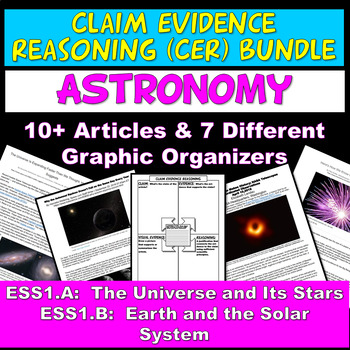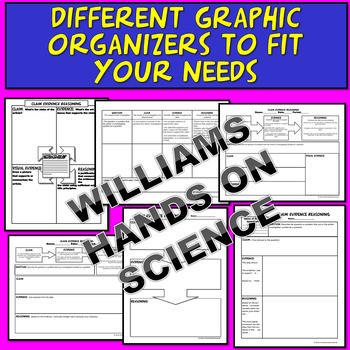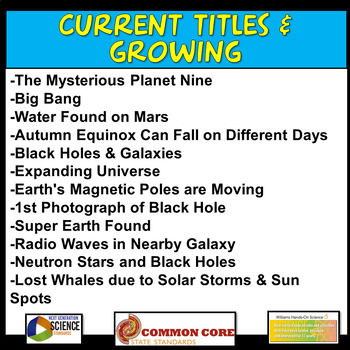NGSS ESS1.A ESS1.B Claim Evidence Reasoning Astronomy Bundle Graphic Organizers
- Zip
Products in this Bundle (17)
showing 1-5 of 17 products
Description
Students learn about various current events and discoveries in Astronomy through a C.E.R. (Claim Evidence Reasoning) graphic organizer. This is great for getting your students to explain phenomena in a meaningful way and it allows you as the instructor to adequately assess their understanding of concepts. The students figure out what the "Claim" is in the article, they then use data that supports the claim in the "Evidence" section, draw visual evidence and then explain why the evidence supports the claim in the "Reasoning" section.
You also get 7 different generic templates used for any current events that apply to your content. Any time I see an interesting article that applies to what we are learning, I use these as my Go-To templates!
These are great for emergency sub plans and integrating into lessons so that your students can put content into context!
You get the following:
-7 CER Graphic Organizer Templates
-Over 10 astronomy articles (and growing) to print hard copies and/or web addresses for reading off of the computer
-Keys
-CER Teacher Tips
If you want a larger variety of science topics AND save money, take a look at my Claim Evidence Reasoning Mega-Bundle
The following Titles are included:
-The Mysterious Planet Nine
-Big Bang
-Water Found on Mars
-Autumn Equinox Can Fall on Different Days
-Black Holes & Galaxies
-Expanding Universe
-Earth's Magnetic Poles are Moving
-1st Photograph of Black Hole
-Super Earth Found
-Radio Waves in Nearby Galaxy
-Neutron Stars and Black Holes
-Lost Whales due to Solar Storms & Sun Spots
ESS1.A: The Universe and Its StarsEarth and its solar system are part of the Milky Way galaxy, which is one of many galaxies in the universe. (MS-ESS1-2)ESS1.B: Earth and the Solar SystemThe solar system consists of the sun and a collection of objects, including planets, their moons, and asteroids that are held in orbit around the sun by its gravitational pull on them. (MS-ESS1-2), (MS-ESS1-3)This model of the solar system can explain eclipses of the sun and the moon. Earth’s spin axis is fixed in direction over the short-term but tilted relative to its orbit around the sun. The seasons are a result of that tilt and are caused by the differential intensity of sunlight on different areas of Earth across the year. (MS-ESS1-1)The solar system appears to have formed from a disk of dust and gas, drawn together by gravity. (MS-ESS1-2)
Thank you for taking a look!
Please follow me on TpT for new products and check me out on Instagram for my products in action!
Williamshandsonscience Instagram
Related Products
⭐ Claim Evidence Reasoning (CER) North Korea Missile Launch
⭐ Claim Evidence Reasoning (CER) The Physics of Car Crashes
⭐ Claim Evidence Reasoning (CER): Autumn Equinox Can Fall on Different Days
⭐ Claim Evidence Reasoning California Mudslides (Current Event and Sub Plan)
⭐ Claim Evidence Reasoning Growing Bundle
⭐ Claim Evidence Reasoning Plate Tectonics Pangaea Article and Graphic Organizer
⭐ Claim Evidence Reasoning: Government Report on Human Caused Climate Change
⭐ Hurricane Harvey Claim Evidence Reasoning Graphic Organizer
⭐ Hurricane Harvey Claim Evidence Reasoning Graphic Organizer (NatGeo Article)
⭐ Hurricane Irma CER (Claim Evidence Reasoning) Graphic Organizer
⭐ NGSS Black Holes & Galaxies Claim Evidence Reasoning Graphic Organizer
⭐ NGSS Claim Evidence Reasoning (CER) Big Bang Graphic Organizer
⭐ NGSS Claim Evidence Reasoning (CER) High Frequency Sound Waves
⭐ NGSS Claim Evidence Reasoning (CER) Kilauea Volcano Eruption Earthquakes
⭐ NGSS Claim Evidence Reasoning (CER) Oldest Evidence of Life on Land Found
⭐ NGSS Claim Evidence Reasoning The Mysterious Planet Nine Solar System Astronomy
⭐ NGSS Claim Evidence Reasoning (CER) Water Found on Mars
⭐ NGSS Climate Change & Extreme Weather Claim Evidence Reasoning
⭐ NGSS Common Core Claim Evidence Reasoning (CER) Graphic Organizers
⭐ NGSS Current Event Claim Evidence Reasoning California Wildfires
⭐ NGSS Current Event Claim Evidence Reasoning Climate Change May Change Ecosystems
⭐ NGSS Expanding Universe Claim Evidence Reasoning Graphic Organizer
⭐ NGSS Mysterious New Form of DNA Claim Evidence Reasoning Graphic Organizer





